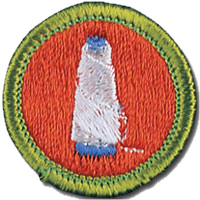Textile


Resources
- Textile Class Perparation Page
- Textile Workbook
- Scoutmaster Bucky's Merit Badge Advancement Quick Reference
- Scoutmaster Bucky's Acknowledgement Form
Textile Requirements Current Scouts BSA requirements
as of May 26, 2025
as of May 26, 2025
1.
Discuss with your counselor the importance of textiles. Explain the terms
fiber, fabric, textile. Give examples of textiles you use every day.
2.
Do the following:
a.
Get swatches of two natural fiber fabrics (100 percent cotton, linen,
wool or silk; no blends) Get swatches of two synthetic fiber fabrics
(nylon, polyester, acrylic, olefin, or spandex). Get a sample of one
cellulosic fabric (rayon, acetate or lyocell).
b.
Give the origin, major characteristics, and general content of each
type of fiber obtained for 2(a). Explain the difference between a
cellulosic manufactured fiber and a synthetic manufactured fiber.
c.
Describe the main steps in making raw fiber into yarn, and yarn into
fabric.
d.
Assume you will soon buy a new garment or other textile item. Tell your
counselor what fiber or blend of fibers you want the item to be, and
give reasons for your choice.
3.
Do TWO of the following:
a.
Visit a textile plant, textile products manufacturer or textile school
or college. Report on what you saw and learned.
b.
Weave a belt, headband, place mat or wall hanging. Use a simple loom
that you have made yourself.
c.
With a magnifying glass, examine a woven fabric, a nonwoven fabric, and
a knitted fabric. Sketch what you see. Explain how the three
constructions are different.
d.
Make a piece of felt.
e.
Make two natural dyes and use them to dye a garment or a piece of
fabric.
f.
Waterproof a fabric.
g.
Demonstrate how to identify fibers, using a microscope identification
or the breaking test.
4.
Explain the meaning of 10 of the following terms: warp, harness, heddle,
shed, aramid, spandex, sliver, yarn, spindle, distaff, loom, cellulose,
sericulture, extrusion, carbon fibers, spinneret, staple, worsted,
nonwoven, greige goods.
5.
List the advantages and disadvantages of natural plant fibers, natural
animal fibers, cellulosic manufactured fibers, and synthetic manufactured
fibers. Identify and discuss at least four ecological concerns regarding
the production and care of textiles.
6.
Explain to your counselor, either verbally or in a written report, five
career possibilities in the textile industry. Tell about two positions that
interest you the most and the education, cost of training and specific
duties those positions require.

